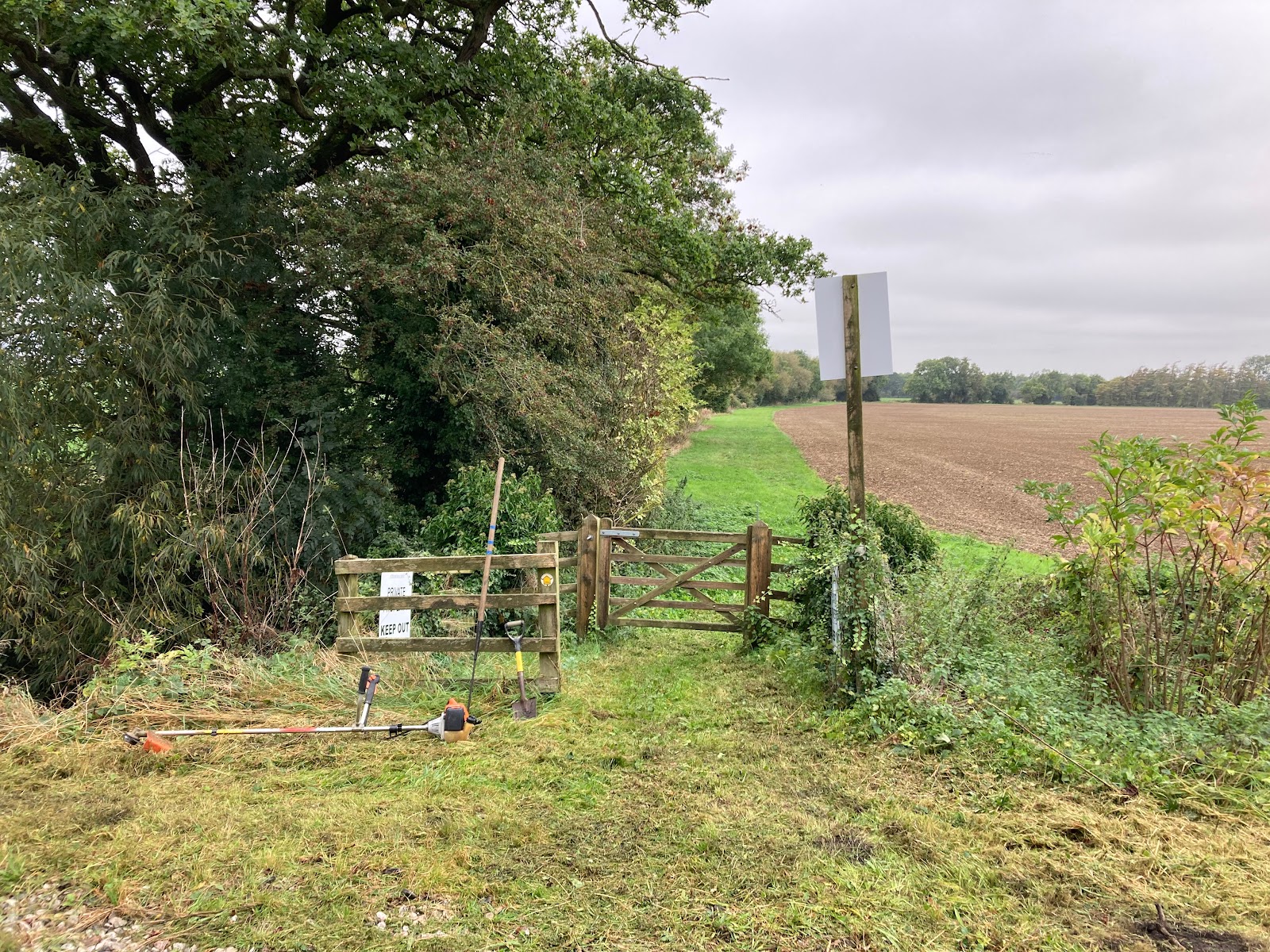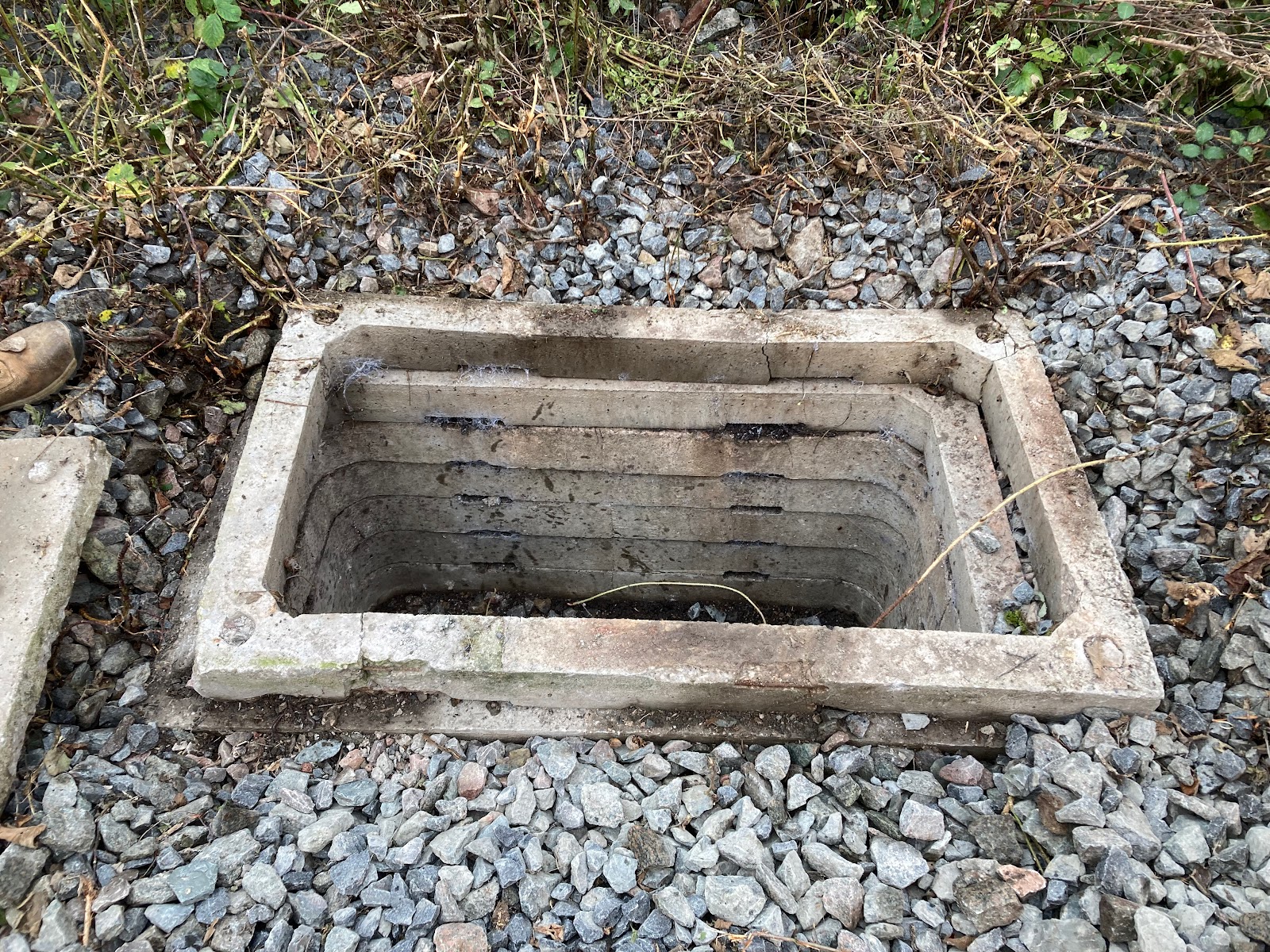Well ‘flattening out’ really – but read on to find out what and where.
Thursday 5th October
In contrast to last week, today we underachieved on the planned job list. Partly because of reduced manpower (only 5 team members attending) and partly because of the added complexity of raising some of the up side cess chambers at Stanton.
For the up side cess chambers at Stanton we took 7 concrete catch pit rings to raise two chambers by one ring each, one by 2 rings and one by 2 rings but also replacing a damaged existing ring. Lids of two chambers were found to be damaged - so a return to Winchcombe to collect replacement blue mesh covers was made.
Also we collected three more concrete rings. These will be used later to raise the height of the berried chamber near mile post 8½. Currently this has a steel plate lid which was buried by 2 to 3 inches of ballast.
Another find was the steel road strength manhole covers of the cess chamber at the foot of the incline from Stanton Yard by the abutment of bridge 10. These were lifted and the inside inspected, all fine inside.
 |
| Inside cess chamber under bridge 10 at Stanton. |
As safe manual lifting and positioning of the concrete rings takes 4 persons, culvert clearance and inspections plus cess and crest chamber vegetation clearance did not commence until after lunch. Hence only the stretch from Stanton bridge 10 to Culvert 7A was completed. The only visual inspection undertaken was that of culvert 7A, the syphon on the low mileage side of the main road bridge at Stanton.
 |
| The main issue at culvert 7A is that the exit ditch across our neighbours land is choked. This leads to standing water in the outlet chamber. |
Additionally Jonathan, our chief plant operator, used the flail to clear vegetation from the vacant up side track bed between Gallery Farm crossing and Stanton Yard; the turning point near bridge 11 and at Stanton Yard including the entrance.
We made a quick check on the condition of Stanton aqueduct. No water was flowing through the aqueduct. The crack on the down side inlet channel appears to be slightly larger than on our previous visit. The upside outlet all looks reasonable. Possibly could be that the downside embankment has dried out a little during the summer but, that is speculation.
Finally we took at look at bridge 7 where some remedial work on the roadway on the up side has taken place. We considered taking on some of the outstanding brickwork repairs, but the more we looked the more we found! Hence we have suggested to the Bridges team that this would be best undertaken by a contractor with erection of scaffolding.
 |
| Recent work on bridge 7 includes new fences and retaining boards. |
Thursday 12th October
Seven of the team attending on what was noticeably a cool autumn day, but thankfully dry.
Nigel and Dave made a quick visit to Prescott Road bridge to trim vegetation on the outlet of culvert 31B by the road side. This is to enable delivery of some top soil to finally complete the work on the roadside outlet ditch/pipe.
First job for Ian, Roger, Stuart and Andrew was placing three concrete rings on the up side cess chamber by milepost 8¼ at Stanton. This was the one previously buried under the ballast.
 |
| Up side cess chamber now one ring above ground level rather than two below. |
Jonathan was on the flail all day - clearing the side of the vacant track bed all the way from Stanton bridge 8 to just north of Laverton foot crossing by milepost 7¼. This included cutting three wider spots between bridge 7 and Laverton foot crossing where it is now safe to park a vehicle. Also cut was the footpaths at Laverton foot crossing.
 |
| Laverton foot crossing looking a lot neater after flailing - and safer too. |
The rest of the team then undertook visual inspections and clearance of culverts 6C, 6B and 6A; plus clearance around the gate at bridge 6 Laverton Meadow Lane and Laverton foot crossing; plus all the cess chambers on both sides between bridge 7 and bridge 6.
 |
| Depth and flow of water this autumn has meant we have not been able to take too many pictures of the insides of culverts. Here is one we did manage - 6B. |
Also undertaken was some further investigations of the cess drain flows between bridges 8 and 7. This suggests that some of the flow from the inlet of culvert 7A is getting into the down side cess rather than flowing out on the up side as the ditch in the adjoining property is blocked.
Finally Ian and Jonathan under took a safety review of the handrails over the Isbourne up side at Winchcombe. Just a few loose screws required tightening with an allen key.
Monday 16th October
Yes, a report for a Monday! Only Jonathan working (at our usual overtime rates!) to supervise the delivery of top soil to Prescott Road and Winchcombe Yard. Ken Pink plant hire had very kindly donated this, plus the delivery in a lorry fitted with a grab. It was worth waiting for, very fine soil with almost no debris. Two grab-fulls were unloaded at Prescott Road to infill the roadside verge behind the sandbag headwall constructed earlier this year. The rest of the load was delivered to the up yard at Winchcombe for use as top covering around the Usk hut and the recently raised main drain manhole. (See the blog post “A busyweek” on the Heritage Herald blog.)
 |
| Lorry mounted grab makes quick work of delivery of the top soil at Prescott Road. [Photo by Jonathan] |
Thursday 19th October
Six members of the team managed to accomplish the planned tasks for the day between the early morning and mid afternoon rains of storm Babet.
Firs thing, Ian and Martin, nipped down to Prescott Road bridge (32) to complete the levelling out (perhaps that is a better description than ‘levelling down’) of the top soil on top of the culvert 31B outlet in the roadside ditch. They also measured up for this missing sections of fence - all that now remains of the work on the 31B outlet, outside of our boundary line.
Nigel, Dave and Andrew headed to Little Buckland to start culvert/cross drain clearance and inspection. A disappointment was that one of our recently serviced heavy duty brushcutters failed to start.
Jonathan undertook some running repairs on the flail, the throttle cable and the starting rope coil had come loose during clearance work the previous Saturday. He then used it to clear the access track from the road at bridge 5. Then the whole length of the vacant down side track bed to culvert 3A at Peasbrook was cut at least one flail width. In some places the cut was wider, including the old farm gate south of bridge 4 where it is possible to just turn a short wheelbase vehicle.
 |
| Cleared access at Little Buckland Bridge (5). Needs a few more cuts to get to bowling green condition! |
Ian, and Martin joined the group at Little Buckland and Peasbrook on the inspections and clearances of cross drain 3A and culverts 3B and 4A. The good news is that there is no significant deterioration in their condition since last year. However, one change from last year was the depth and flow of water. Indicative of a damp summer and a few recent days of heavy rain.
 |
| Inlet of culvert 4A where the main flow was from the low mileage (north) end toe drain. |
This made it unsafe for some of the clearance of vegetation on the steep banks, we will have to return in a drier spell. Also not so good new was the continuing badger activity at Little Buckland. The cheeky animals had even made a bed chamber in one of the down side toe ditch chambers.
 |
| One bedroom detached property suitable for badgers. [Photo by Dave] |
 | |||||
| Most wildlife makes a hasty exit as soon as we try to photograph them. However, this young common toad at Little Buckland was an exception. | |
Friday 20th October storm Babet aftermath
Here is justification of the spending on maintenance and improvement of our drains and culverts. This is the storm overflow brook which runs behind Churchward House and then the down side of Winchcombe Yard. Without this, all the water running off Langley Hill to the west of Winchcombe would be running through the platforms at Winchcombe station.
 |
| [Photo by Infrastructure Manager, Ian] |
